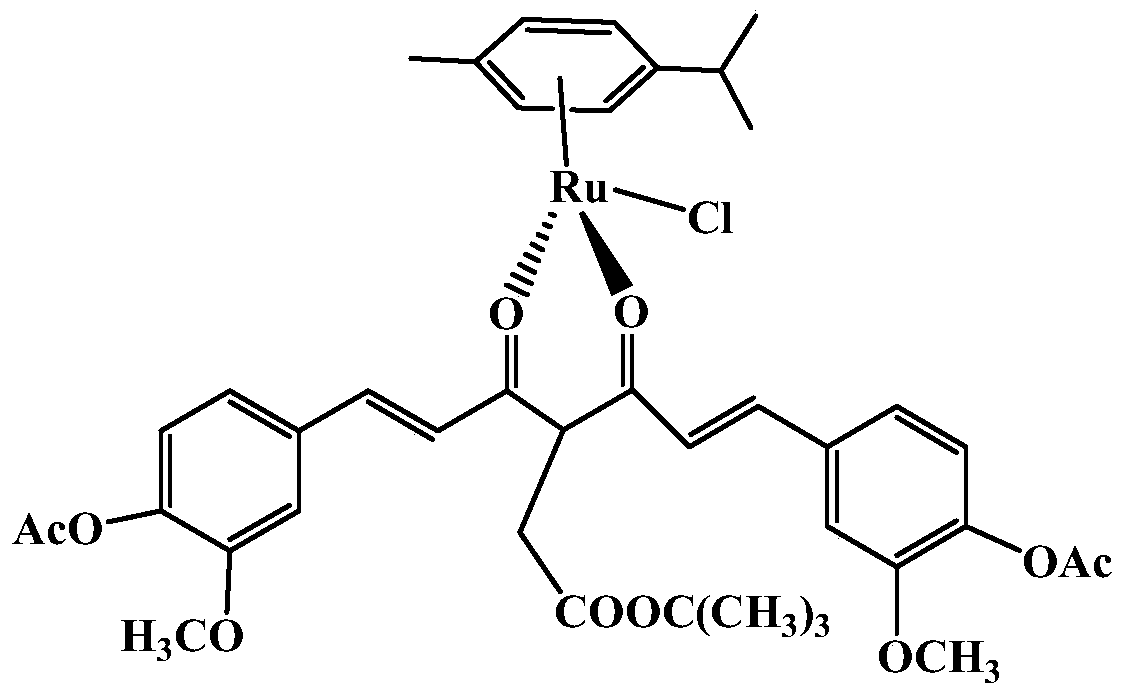β-cyclodextrin and tert-butoxyacetyl ruthenium compounds and their application in microcontact printing technology
A tert-butoxyacetyl ruthenium, micro-contact printing technology, applied in the direction of ruthenium organic compounds, platinum group organic compounds, printing, etc., can solve the problems that β-cyclodextrin application has not been reported, and achieve low cost, strong resistance Effects of tumor activity and easy availability of raw materials
- Summary
- Abstract
- Description
- Claims
- Application Information
AI Technical Summary
Problems solved by technology
Method used
Image
Examples
Embodiment 1
[0028] 1) Substrate surface treatment: Soak polymethyl methacrylate in 45% isopropanol aqueous solution for 30 minutes, wherein the mass percentage of isopropanol solution and polymethyl methacrylate is 1:1. Then put it in 2mol / L sulfuric acid solution, and soak it for 15 minutes at a temperature of 55°C, then wash it with water, and carry out vacuum drying at a temperature of 60°C, and introduce carboxyl groups on the surface of the polymer substrate to obtain carboxylated polymer. Methyl methacrylate base;
[0029] 2) Prepare a composite solution of β-cyclodextrin and tert-butoxyacetyl ruthenium compound: dissolve the β-cyclodextrin in water to obtain an aqueous solution of β-cyclodextrin with a concentration of 3 g / L, and in every liter of β-cyclodextrin Add 0.8 g of tert-butoxyacetyl ruthenium compound to the aqueous solution, and then use an ultrasonic instrument to adjust the frequency to 20 kHz for 30 minutes to obtain a uniformly dispersed composite solution of β-cyclo...
Embodiment 2
[0034] 1) Substrate surface treatment: soak polymethyl methacrylate with 55% isopropanol aqueous solution for 60 minutes, wherein the mass percentage of isopropanol solution and polymethyl methacrylate is 1 ∶ 5. After taking it out, place it in a 3mol / L sulfuric acid solution, soak it for 20 minutes at a temperature of 65°C, then wash it with water, and carry out vacuum drying at a temperature of 65°C to introduce carboxyl groups on the surface of the polymer substrate to obtain Carboxylated polymethyl methacrylate base;
[0035]2) Prepare a composite solution of β-cyclodextrin and tert-butoxyacetyl ruthenium compound: dissolve β-cyclodextrin in water to obtain an aqueous solution of β-cyclodextrin with a concentration of 6 g / L. Add 0.8 g of tert-butoxyacetyl ruthenium compound to the aqueous solution, and then use an ultrasonic instrument to adjust the frequency to 20 kHz for 60 minutes to obtain a uniformly dispersed composite solution of β-cyclodextrin and tert-butoxyacetyl...
Embodiment 3
[0040] Human normal epidermal cells HaCaT were cultured in Dulbecco's Modified Eagle's Medium (DMEM) medium (containing 10% newborn bovine serum) at 37°C and 5% CO 2 Cultivate under conditions, and change the culture medium once every 1-2 days. When the cells grow to the logarithmic phase, the metal pattern substrates obtained in Example 1 and Example 2 and the polymethyl methacrylate substrate before carboxylation are added for treatment. Place the cells in a 96-well plate with 0.25% trypsin at 37°C, 5% CO 2 Incubator cultivation. After 2 to 4 hours, each culture plate was added with the metal pattern substrate obtained in Example 1 and Example 2, the polymethyl methacrylate substrate before carboxylation, and the cells cultured in complete culture medium as the experimental group and the control group. Contain cells and culture medium as a blank control, move the culture plate to 37°C, 5% CO 2 Incubator cultivation. After 24 hours, discard the culture medium, wash the pl...
PUM
 Login to View More
Login to View More Abstract
Description
Claims
Application Information
 Login to View More
Login to View More - R&D
- Intellectual Property
- Life Sciences
- Materials
- Tech Scout
- Unparalleled Data Quality
- Higher Quality Content
- 60% Fewer Hallucinations
Browse by: Latest US Patents, China's latest patents, Technical Efficacy Thesaurus, Application Domain, Technology Topic, Popular Technical Reports.
© 2025 PatSnap. All rights reserved.Legal|Privacy policy|Modern Slavery Act Transparency Statement|Sitemap|About US| Contact US: help@patsnap.com


